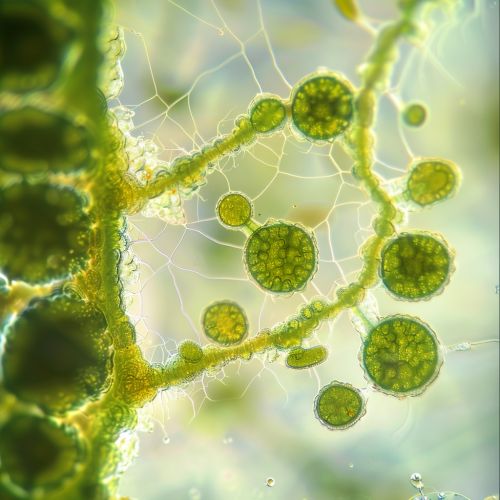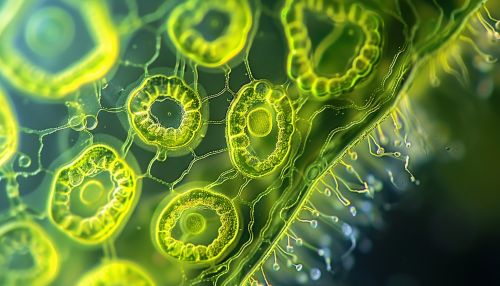Carbon fixation
Introduction
Carbon fixation is a crucial process in the global biosphere, involving the conversion of atmospheric carbon dioxide (CO2) into organic compounds by living organisms. This process plays a vital role in the carbon cycle, which regulates the Earth's climate and sustains life on our planet.
Overview
Carbon fixation is primarily achieved through the process of photosynthesis, performed by green plants, algae, and some bacteria. These organisms, known as autotrophs, utilize sunlight to convert carbon dioxide and water into glucose, a type of sugar that serves as a primary energy source for most life forms. This process also releases oxygen (O2) as a byproduct, which is essential for the survival of aerobic organisms.
Process of Carbon Fixing
The process of carbon fixation occurs in the chloroplasts of plant cells during photosynthesis. It involves several steps, each catalyzed by specific enzymes. The most common pathway for carbon fixation is the Calvin cycle, also known as the C3 pathway.
Calvin Cycle
The Calvin cycle, named after its discoverer Melvin Calvin, is the most common pathway used by plants and algae to fix carbon. It occurs in the stroma of the chloroplasts and involves three main stages: carbon fixation, reduction, and regeneration of the starting molecule.
In the first stage, the enzyme RuBisCO (Ribulose-1,5-bisphosphate carboxylase/oxygenase), the most abundant protein on Earth, catalyzes the reaction between CO2 and ribulose-1,5-bisphosphate (RuBP), a five-carbon compound. This reaction produces a six-carbon compound that immediately splits into two molecules of 3-phosphoglycerate (3-PGA), a three-carbon compound.
In the second stage, 3-PGA is reduced to glyceraldehyde-3-phosphate (G3P), a sugar, in a process that requires ATP and NADPH, energy-rich compounds produced in the light-dependent reactions of photosynthesis.
In the third stage, some G3P molecules are used to regenerate RuBP, allowing the cycle to continue. The remaining G3P molecules can be used to produce glucose and other organic compounds.


Alternative Pathways
Some plants, particularly those in hot or dry environments, use alternative pathways for carbon fixation that are more efficient under these conditions. These include the C4 and CAM (Crassulacean Acid Metabolism) pathways.
C4 Pathway
The C4 pathway, named for the four-carbon compound it produces, is used by plants such as corn and sugarcane. In these plants, carbon fixation and the Calvin cycle occur in different cells, which helps to minimize the loss of carbon dioxide and water through stomata, the pores in plant leaves.
CAM Pathway
The CAM pathway, used by succulent plants and cacti, involves the temporal separation of carbon fixation and the Calvin cycle. These plants fix carbon dioxide at night, when the air is cooler and more humid, and store it as malic acid. During the day, when the stomata are closed to prevent water loss, the malic acid is decarboxylated to release CO2, which then enters the Calvin cycle.
Role in the Carbon Cycle
Carbon fixation plays a crucial role in the global carbon cycle, a biogeochemical cycle that regulates the Earth's climate by controlling the concentration of carbon dioxide in the atmosphere. Through photosynthesis, autotrophs remove CO2 from the atmosphere and convert it into organic compounds, which are then consumed by heterotrophs, organisms that cannot fix carbon themselves.
Significance
Carbon fixation is essential for life on Earth. It provides the organic compounds that serve as the building blocks for all living organisms and the energy that drives their metabolic processes. Moreover, by removing CO2 from the atmosphere, carbon fixation helps to mitigate the effects of global warming.
